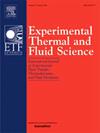Scaling mean velocity and Reynolds stress of a turbulent boundary layer submitted to an adverse pressure gradient
IF 3.3
2区 工程技术
Q2 ENGINEERING, MECHANICAL
Experimental Thermal and Fluid Science
Pub Date : 2025-08-11
DOI:10.1016/j.expthermflusci.2025.111578
引用次数: 0
Abstract
Despite considerable progress in understanding zero pressure gradient boundary layers, turbulence in adverse pressure gradient (APG) boundary layers remains less well understood, particularly in high Reynolds number flows. Unfavorable pressure gradient regions are commonly encountered in industrial applications, but turbulence models often lack the physical basis necessary for reliable predictions in these flows. This study focuses on analyzing the effects of adverse pressure gradient on boundary layer scaling, essential for predicting flow characteristics and validating turbulence models. Building on recent advances in experimental methods and using large-scale particle image velocimetry (PIV), the research aims to provide an analysis of turbulent boundary layer flows in APG. Experiments have been carried out in a wind tunnel using inclined plates to induce pressure gradients at an angle of , complementing an existing database obtained at (see Cuvier et al., 2017) and offering new insights into flow behavior. An analysis of the literature has enabled the authors to compare various scaling approaches and to propose a scaling that is suitable for both mean velocity and Reynolds stress.
标度紊流边界层在逆压梯度作用下的平均速度和雷诺应力
尽管在了解零压力梯度边界层方面取得了相当大的进展,但对逆压梯度(APG)边界层中的湍流仍然知之甚少,特别是在高雷诺数流动中。在工业应用中,通常会遇到不利的压力梯度区域,但湍流模型往往缺乏对这些流动进行可靠预测所需的物理基础。本研究的重点是分析逆压梯度对边界层尺度的影响,这对预测流动特性和验证湍流模型至关重要。基于实验方法的最新进展,利用大尺度粒子图像测速技术(PIV),本研究旨在对APG湍流边界层流动进行分析。我们在风洞中进行了实验,利用倾斜板在- 8°角处诱导压力梯度,补充了在- 5°角处获得的现有数据库(见Cuvier et al., 2017),并提供了对流动行为的新见解。对文献的分析使作者能够比较各种标度方法,并提出适用于平均速度和雷诺应力的标度。
本文章由计算机程序翻译,如有差异,请以英文原文为准。
求助全文
约1分钟内获得全文
求助全文
来源期刊

Experimental Thermal and Fluid Science
工程技术-工程:机械
CiteScore
6.70
自引率
3.10%
发文量
159
审稿时长
34 days
期刊介绍:
Experimental Thermal and Fluid Science provides a forum for research emphasizing experimental work that enhances fundamental understanding of heat transfer, thermodynamics, and fluid mechanics. In addition to the principal areas of research, the journal covers research results in related fields, including combined heat and mass transfer, flows with phase transition, micro- and nano-scale systems, multiphase flow, combustion, radiative transfer, porous media, cryogenics, turbulence, and novel experimental techniques.
 求助内容:
求助内容: 应助结果提醒方式:
应助结果提醒方式:


